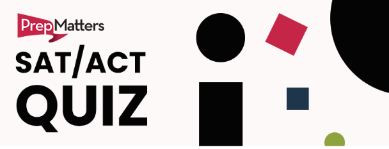Posted by: Aaron Golumbfskie on June 18, 2025
We made quite a few predictions in the last year as the digital SAT made its debut, both about the changes to the test itself and also about how students would react to those changes. Here we are, a year and, for us, a thousand or so students later. So, what did we get right and what did we miss? And what can students just starting their SAT prep journeys learn from the experiences of the first crop of US students to test?
Prediction One: Students will be tempted by the shorter, digital SAT.
This one was 100% true. The College Board was super effective in its online marketing campaign: Essentially every student came in the door already knowing that the digital SAT is an hour shorter than the ACT. That fact certainly swayed their thinking, and not always for the better. Perhaps more than any year in recent memory, students this year switched from the SAT to the ACT or the ACT to the SAT – so many, in fact, that we blogged about it. Perhaps it was the college board’s aggressive marketing campaign, perhaps it was the fact that one test was digital and the other paper, but whatever the reason, students have been wondering about the road not taken. Let that be a lesson to students new to the process: taking time early on to determine which test is more aligned with your skills – and not simply more convenient – can save you time and indecision later!
Verdict: Absolutely True
Prediction Two: Vocabulary will be more heavily emphasized on the digital SAT.
We knew last year that sentence completion questions, for which students need to supply a vocabulary word into a blank in a short passage, were making a comeback on the SAT, but we weren’t sure the extent to which that vocabulary would permeate (as the SAT would say) the rest of the test. Of course, the SAT has always featured more challenging vocabulary and a generally higher level of diction than the ACT, and that remains true of the digital test. So the real question is, “Does the new SAT challenge students’ vocabularies more than did the previous iteration?” And the answer is, “Not really.” As it turns out, most of the challenge in the new SAT sentence completions is correctly parsing the context of the passage itself and not in identifying abstruse vocabulary from the answer choices. Of course, that context is itself written at a college reading level, so students whose vocabularies aren’t as expansive will likely still have an easier time reading – and understanding – passages on the ACT than those on the SAT.
Verdict: Somewhat True
Prediction: Shorter reading passages aren’t necessarily easier reading passages.
I don’t think a single student all year has lamented the loss of the “long” (80-90 lines) passages of the paper SAT. However, they haven’t all been happy about the newer passages, either. Specifically, we predicted that the new Information and Ideas section was going to prove difficult, and it certainly has. These questions require more from students than simply reading a short passage. Testers need to understand the structure of the arguments being made, distinguish evidence from supposition, and – in some cases – make a logical deduction of their own based on what they’ve read. Not all students have been comfortable making the transition from longer passages testing recall and understanding of main ideas to shorter passages that require more close reading and analysis of argumentation. Students struggling with those aspects of the test might be well served by checking out the ACT, which retains the legacy longer passages with multiple questions.
That also brings us to another prediction we made: the cognitive load of the new SAT would rise since each question now has its own short passage rather than fewer longer passages with multiple questions. That’s also manifested as a very real struggle for students, who’ve reported that their brains are just “too full” by the middle of that second reading module. Well prepared students, however, understand that they can answer the questions in any order they like! Many have found breaking up those difficult argumentation questions with some “easier” grammar or transition questions to be one successful way to not be overwhelmed by what can feel like a barrage of shorter passages.
Verdict: True
Prediction: Desmos is a game-changer.
This one is so true it’s almost unfair to students who don’t have experience with Desmos. Not only can students use the bundled graphing calculator to find solutions to problems they don’t know how to set up algebraically, but they can also wisely use it to solve other problems they know how to do, but more quickly and easily. Students who haven’t really engaged with Desmos in school are encouraged to start right now – the SAT has acknowledged that our math students are living in a digital age even if their math classes have not, and knowing when and how to use your digital tools can be as important as knowing the algebra! One caveat here, though: Desmos is tremendously effective in helping students turn poor or middling math scores into good scores. Desmos, however, is not going to be nearly as helpful turning really good scores into truly exceptional ones – for that, students will absolutely need to be comfortable with all the algebra.
Verdict: True
Prediction: A lack of resources will make it difficult for dedicated students to fully prepare for the digital SAT.
We’re happy to be wrong about this one. The College Board has done a good job this year of releasing practice materials via BlueBook, their online testing tool. Students currently have access to eight fully adaptive practice tests, which is as many as most will need. College Board also hosts an Educator Question Datatabase which features hundreds of additional questions in the current format that students can use for valuable additional practice.
Verdict: False
Prediction: Sparse score reports and lack of feedback will make it more difficult for students to prepare for a retest.
For us as tutors and for the students who choose to retake the test, this one really hurts: students no longer receive any meaningful feedback on their test day other than the overall section scores. Gone are the days when students could understand the type of questions they missed on the last round or even order a copy of the released test from the College Board. The digital SAT score report doesn’t even tell students how many questions they’ve gotten right or wrong, let alone what kind of questions those were! That’s proved especially challenging to two groups of students at opposite ends of the spectrum: students for whom testing doesn’t come easily and students looking for elite 1500+ scores. While being very different learners, those students usually test multiple times over the course of the year and – in the past – would heavily rely on detailed score reports to guide their long-term work. It’s important for all students, but especially those cohorts, to prepare for the uncertainty that’ll be coming their way by trying to themselves take as much feedback out of the test as possible. Be sure to write a note to yourself or your tutor with a brain dump to memorialize the day while the details are fresh so you can reopen it when scores are returned to try to help yourself understand what really happened and put yourself in the best position moving forward.
Verdict: Very unfortunately true
Prediction: The ACT will respond quickly with a digital test of its own.
This one is a little more complicated. The ACT is in the midst of transitioning to the “Enhanced ACT”, which debuted in April 2025 and becomes the only version of the test in September, when the ACT will make it available to students both digitally and in paper form. And, as expected, it’s also been trimmed to a snappier two hours to compete with the digital SAT. The ACT’s giving students a choice between a paper test and a digital test is great in theory, but thus far that choice has been only nominal. Unlike the digital SAT, which students can take on their own devices, the digital ACT must be taken on school managed devices, a proposition that not many test centers have embraced. For example, two months before the first digital test in April, the closest available seat to DC was actually in Pennsylvania. Unfortunately, we don’t anticipate schools to change until the ACT changes its policy on student-owned devices. The silver lining here is that the digital ACT, unlike the digital SAT, is a static test. That means students face exactly the same questions and format on a screen or on paper. And there’s no Desmos integration on the ACT, so there’s really no real reason for students to even want to take a digital ACT this year. Yes, it’s a new, “enhanced” ACT, but for most kids it’s still going to be a paper ACT.
Verdict: It’s complicated
We’ll be opining on the upcoming changes to the ACT this year as it rolls out and look forward to checking back in next year to see how we did! Until then, we’ll be busy adding to what we already know about the new SAT and learning as much as we can about the latest updates on the upcoming digital ACT. Please reach out to us if we can be of help to you or your family as you try to do the same.




